#C.M. Saunders
Explore tagged Tumblr posts
Text
Halloween treats that won’t weigh you down! OUT OF TIME: TRUE PARANORMAL ENCOUNTERS is here—free preview of “Floor Song Tango” below!
Halloween treats that won’t weigh you down! OUT OF TIME: TRUE PARANORMAL ENCOUNTERS is here—free preview of “Floor Song Tango” below!

View On WordPress
#A. Morton#Amanda Cecilia Lang#Brianna Malotke#Bryan Stubbles#C.J. Hislop#C.M. Saunders#Caillou Pettis#Caryn Larrinaga#Catherine A. MacKenzie#Chris Tyroak#Errica Chavez#Ghost Stories#John Stratton#Judith Baron#Kelli A. Wilkins#L.E. Daniels#Lehua Parker#Lisa H. Owens#N.A. Battaglia#Nat Whiston#Nathan Alling Long#Nathan D. Ludwig#Out of Time: True Paranormal Encounters#real haunted houses#Rebecca A. Demarest#scary tales for Halloween#Susan E. Rogers#T.J. Tranchell#Timber Ghost Press#true ghost story books
0 notes
Text
SHORT STORY: Twitch by C.M. Saunders
SHORT STORY: Twitch by C.M. Saunders
Twitch It started with a twitching left eyelid. Nothing major. More annoying that anything else. She’d had similar afflictions before, but they usually petered out after a while. This one didn’t. It just kept getting worse. The eyelid developed a life of its own, fluttering away seemingly at will. One spasm led to another, then another, until eventually she lost all control of her facial…

View On WordPress
#100 Words#100 Words Story#Back from the Dead#C.M. Saunders#Christian Saunders#Crimson Streets#Feverish Fiction#Fortean Times#Guest Post#Halloween#Halloween Extravaganza#Halloween Extravaganza 2021#Haunted MTL#horror#ParABnormal#Short Story#The Literary Hatchet#Twitch
0 notes
Text
ART EVALUATION - MULTIVERSE ASSIGNMENT
themes of the assignment
The multiverse assignment took us through a variety of artistic styles, drawing, printmaking, typography and collage, but there was also a narrative element introduced through the penguin book, we were tasked several times to draw inspiration from narrative elements from the book, or to depict scenes from it, this I felt was similar to fine art, however while on the computers we worked on 'postcards' (personally though I always felt their purpose was more like covers for our books), which again had inspiration taken from the book, this reminded me of graphic design; we were attempting to express a product through a visual means.
the three ‘postcards’ that had text added to them, overall i find that the first one below is my favorite, the central image i feel is a strongly emotive one, figures shrouded in darkness, almost in solidarity over some tragedy, which is why i annotated it “a reminder of better days”, as a reference to how i felt the image was tragic.

this image i annotated it with words associated with god, the drawing i used because i wanted it to resemble an old medieval representation of an angel, which i feels far more visually interesting, and below it is the shattered sky and broken buildings, riven by strange flames, all part of the ‘wrath’ and ‘profound fear’.

here was see the hand receiving what should cause ‘the rapture’ i used the sun as the object because i felt as though the sun’s connection to the heavens, and it being unreachable was going to add to the piece. i also inverted the colours of each of the annotations, to draw contrast between the statements.
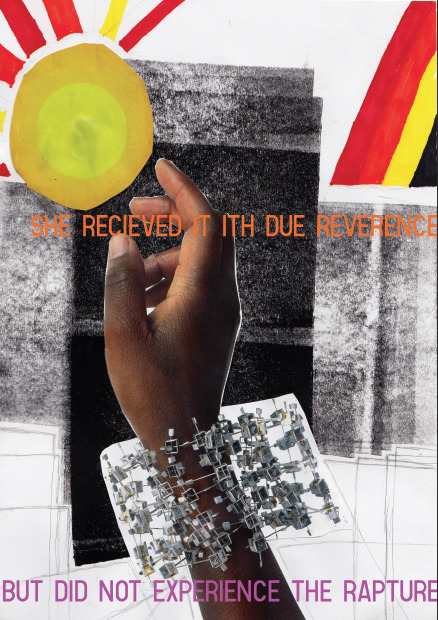
This all being said I'm confused over how the multiverse plays into this, the assignment was about creating art based around a narrative, not around other universes.
Two artists I felt influenced the art I made during the assignment were Brooks salzwedel and pokras lampras, Brooks' art I have already examined, still, he depicts floating land masses, and strange forested scenes obscured by mist, while pokras lampras is an asemic writing artist, his particular
Brooks salzwedel
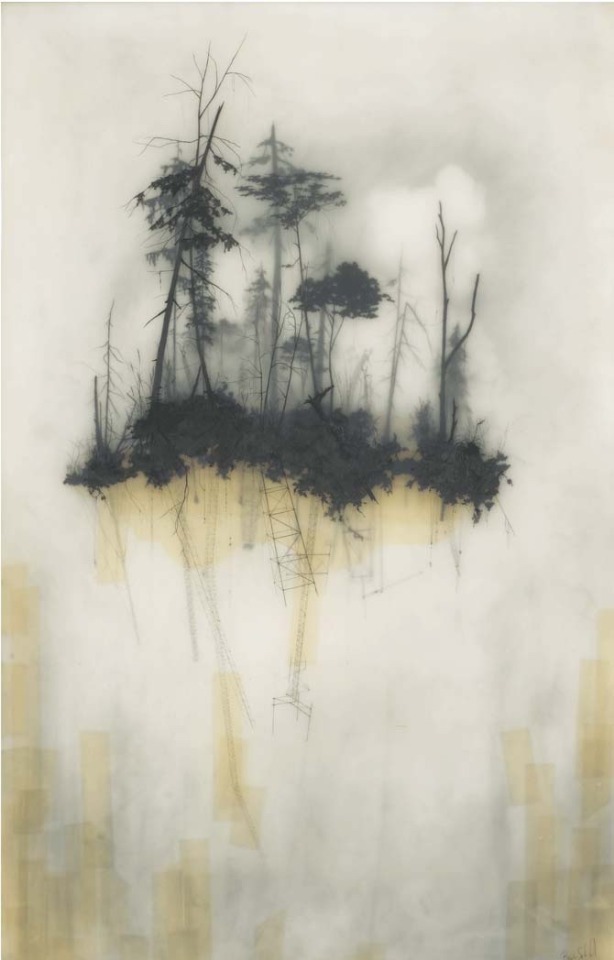
style was structured and merged aspects of Cyrillic, English, Greek and Arabic creating an interesting visual style.
Pokras lampras

What did we learn in lesson
This assignment did not focus on new artisic methods (in comparison to the last unit we learnt screenrinting, intaglio, chalk, graphite etc.) but rather ways to express ideas through it, in this case through the aforementioned narrative.
Animation:
animation is relatively simple, animations are composed of several frames, then the amount of frames per second will determine how the animation plays put, generally the higher frame rates are used for smoother, more high effort animations, 24 fps (Frames Per Second) is industry standard.
In a programme the last frame can be viewed to better let the animator decide where they want to go with the animation.
Light box art:
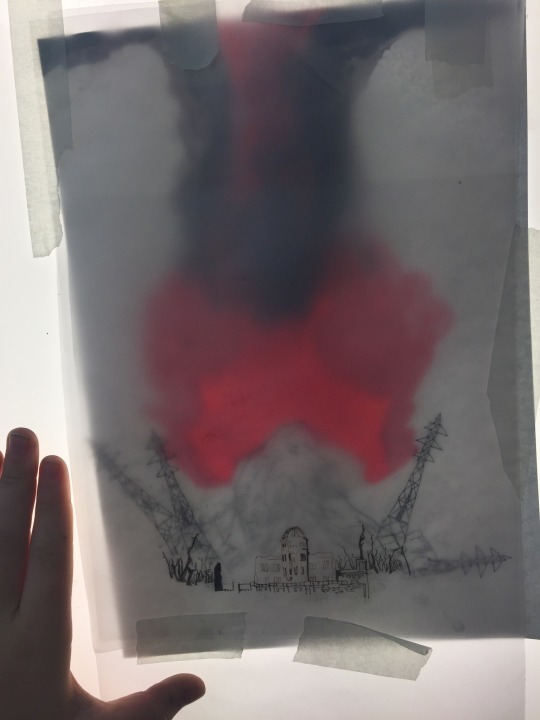
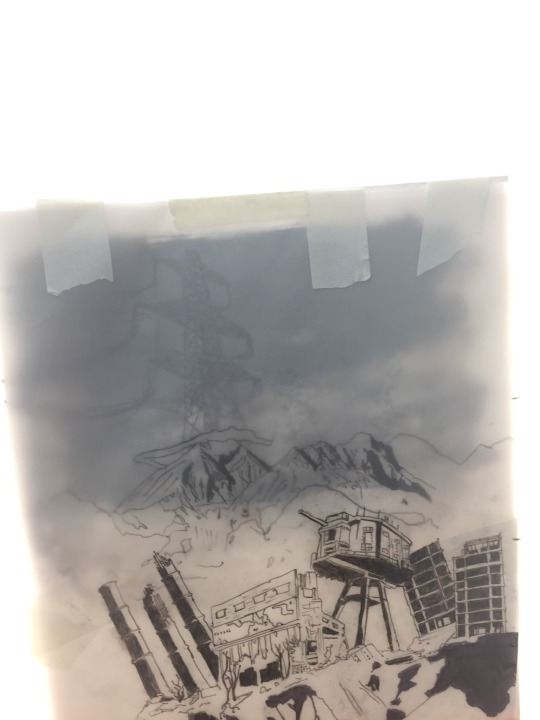
our light box art used tracing paper, each piece of paper was drawn on, the penned, the most 'misted' paper would be at the back, giving an impression of dictance, the paper in fromt would similarly appear closer to the veiwer.
Though as for what we used, screen printing, digital, painting, drawing were all used, of note was the continued use of animations in digital atr.
the use of light boxe was interesting particularly the use of layered tracing paper to create a obfuscated image, though I personally wonder how I could use them in my own art.
Out of lesson
digital art became my focus, I've found my transition from traditional methods difficult, lines are less stable, and dealing with confusing interfaces has proven itself difficult.
The quality of my artwork has been reduced as a result, but this is expected when moving to a new, unfamiliar medium.
Though digital art has allowed me to use colours freely, which again is difficult, as I never developed any real sense over how to use colours using traditional drawing methods.
Inspiration
Additionally I asked each individual artist the same three questions about their work, which were
what is your source of inspiration? (meaning what initially inspired you and what continues to)
how did you start? (what did you draw initailly, when?)
what processes and materials do you use?
void_illustration - Richard Saunders Illustration
Richards art either is obviously biological, where a creature is depicted, or has a distinctly biological edge to it, metals seem to bend,twist and stretch like flesh, nothing seems to be truly just a machine or device, rather every ridge, bulge and groove hints at a more organic truth to his figures and objects.
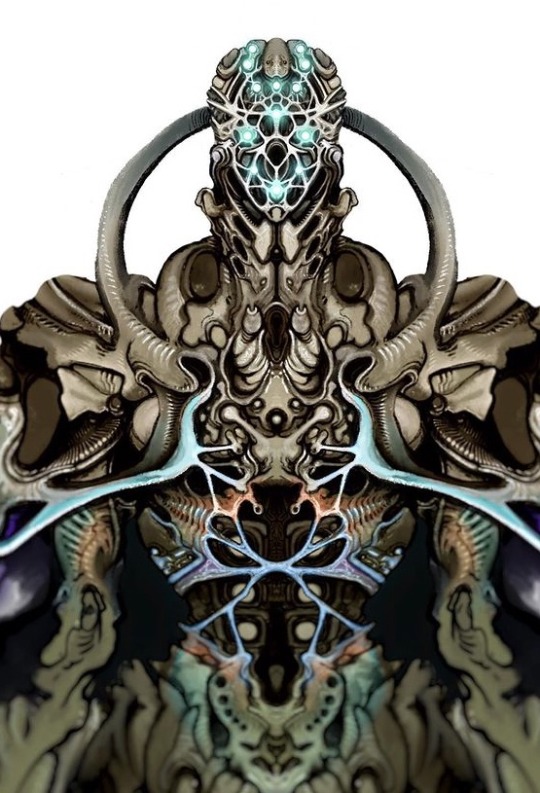
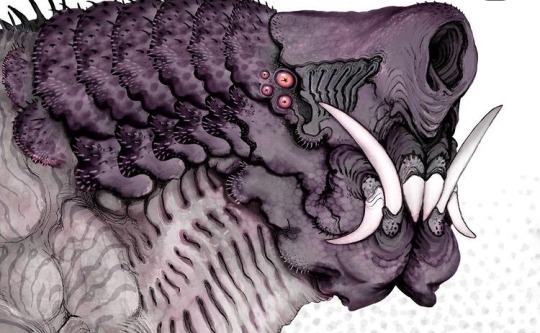
1. im inspired by so many things, its good to pull from a wide range of inspirations.
2. Ive been drawing for a long time, im not professional but im hoping to change that, most of my work forms into narrative universes and then develops on from there.
3. For materials I use a range. My 'bio warrior' series is mainly pencil sketches with marker colours and white paint pen highlights. My brown paper dragons are watercolour on strathmore toned tan paper, lined digitally, though I will layer them up further with paint and markers.
Fuelstains - Nikolay Georgiev
His work similarly to Richard's trends to directly be a creature or rather, monster, these organism often have strongly textured skin, often appearing to have many grooves, showing the musculature underneath, then there are his mechanical pieces, either directly depicting a machine of some kind, such as a robot, or depicting a human who has been massively altered by technological augmentations.

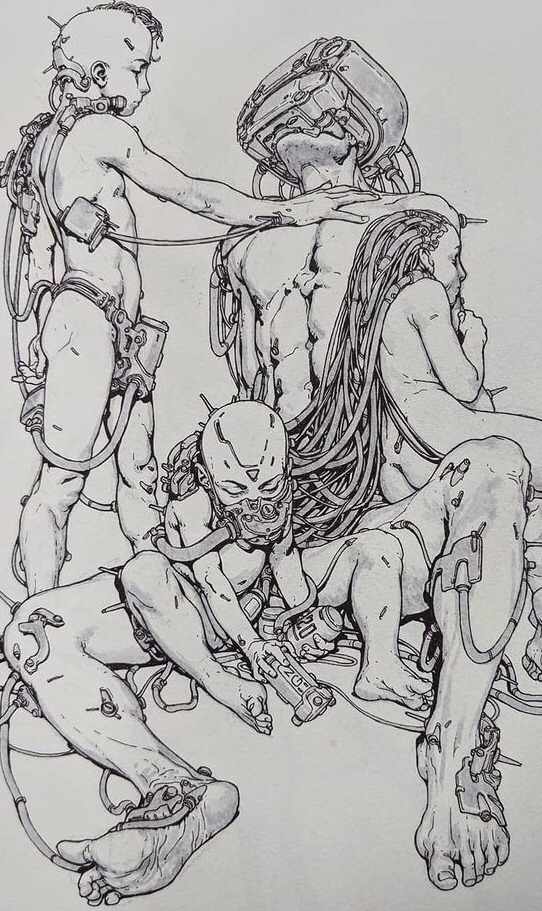
1.I was initially inspired by comics, as a kid, stuff like spiderman, bat man and transformers, but later on it could be anything that inspires me.
2.I started in primary school and it was mostly superheros or stuff from movies.
3.Pencil, ink fineliner, brushpen, watercolour, ballpoint pen, digital.
Milesr.art – Miles R art
miles' art focuses on creature drawings, particularly drawings of alien life, creating some truly bizarrely fascinating, most bearing little resemblance to earth organisms, if any. Another aspect of Miles' work that I appreciate is that it seems grounded, the animals, in spite of their bizzarreness still seem like they could exist.
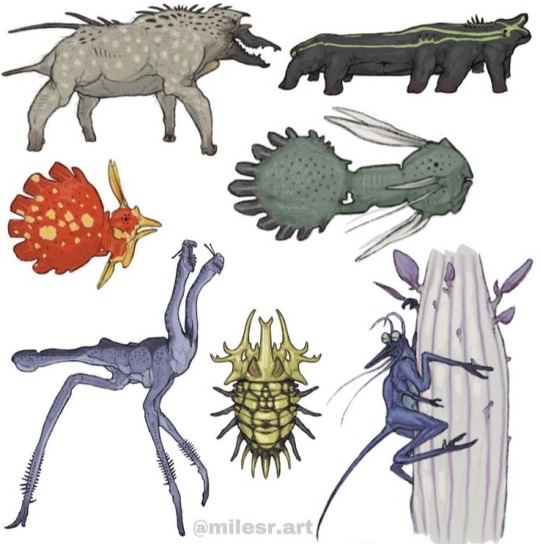
1.some of my biggest sources of inspiration:
- C.M koseman, Brynn metheny, and dougal dixon are some of my most inspiring artists
-just thinking about the natural world in general like on our planet
2.what initially inspired me to draw and that goes into number 2) in kindergarten I saw some kid drawing a honey comb pattern with neon markers and was like huh okay im going to do that but better.
And I always drew monsters and characters, always becoming more based on science overtime, and here I am now.
3.Now I exclusively make finished things digitally with my ipad pro and apple pencil using procreate, but I often make sketches on post it notes with just regular pencil. In terms of processes I feel like I just do what I do it, its hard to define ones process.
1 note
·
View note
Text
DOA III: Extreme Horror Anthology
DOA III: Extreme Horror Anthology
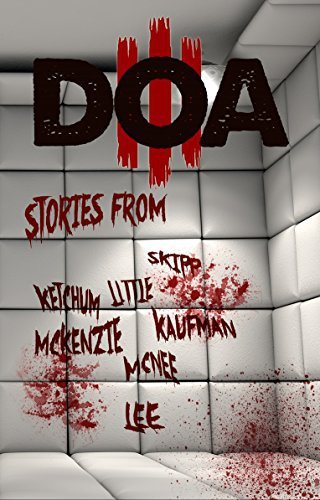
After six years and more than fifty authors, the Unholy Trinity is complete. This third installment in the DOA series offers thirty stories from the originators of splatterpunk as well as the newest voices in extreme horror.
You’ll laugh…you’ll cry…you’ll vomit Don’t say we didn’t warn you.
Stories from Bentley Little -Jack Ketchum & Edward Lee – Shane Mckenzie – Wrath James White – Richard…
View On WordPress
#Adrian Ludens#Airika Sneve#Alistair Rennie#Bentley Little#Betty Rocksteady#C. Cameron Rossi#C.M. Saunders#Christoph Weber#Daniel I. Russell#David Sandner#DOA III#Edward Lee#Eric J. Guignard#extreme horror#Garrett Cook#Hal Bodner#horror#Jaap Boekestein#Jack Ketchum#Jeff Strand#John McNee#John Skipp#Joshua Viola#K. Trap Jones#Kristopher Rufty#Kristopher Triana#Lily Hayes Kaufman#LLoyd Kaufman#Luciano Marano#Richard Christian Matheson
0 notes
Photo

Terrors Unimagined: An Anthology of the Supernatural and Horrific, edited by Karen T. Newman, Left Hand Publishers, 2019. Cover design by Paul K. Metheney, info: lefthandpublishers.com.
An Anthology of the Supernatural and Horrific that oozes past the boundaries of your imagination. Far beyond what you can imagine lies a dreamscape full of the unexpected and the unexplainable. The supernatural, the paranormal, monsters, demons, magic, witches, and inconceivable horrors reside in a world of… Terrors Unimagined. An international cadre of authors, both new and experienced, lead you down a path to the other side of the unbelievable with stories unique and thought-provoking. This anthology of supernatural and horror-inspiring short stories drags us screaming into a world of creatures and nightmares undreamed of. Prepare to ponder your nights away. Sleep is no longer an option.
Contents: Writer’s Block by Brit Jones The Librarian’s Apprentice by Cedric Tan Soul Dew by Keith Gouveia The Devil’s Fingers by Clark Roberts One Night in the Roach Motel by Seth Peterson Norn by Ailish Sinclair. The Burden Unknown by Timothy Vincent The Tale of Days by Bill Davidson. Letters of the Raj by R.W. Warwick Bathtub Sleepers by Ann Stawski. Clay Figures by Valerie Lioudis Blessing by Charlotte Platt The Toughest Nut To Crack by George Karram Mama Bear by Kathryn Collins The Gift by Jonathan Palmer Man-i-kin by Matt Kolbet Lakeside Park by C.M. Saunders The Lifeboat by Todd Zack Dress Up by Gary Van Haas The Toy-Doll from Her Youth by Sergio Palumbo Boneglow by G. Ted Theewen Sins of War by Shaun Meeks Medium by Trippenbach & Jessop A Beckoning Muse by Jay Seate To Catch a Dreamer by Mary-Jean Harris Necessary Elvis by Jerry L. Wheeler
9 notes
·
View notes
Photo

𝗦𝗣𝗟𝗔𝗧𝗧𝗘𝗥 𝗜𝗡𝗞 𝗜𝗦 𝗛𝗘𝗥𝗘. 𝗣𝗨𝗧 𝗔𝗪𝗔𝗬 𝗬𝗢𝗨𝗥 𝗔𝗡𝗘𝗦𝗧𝗛𝗘𝗧𝗜𝗖𝗦 𝗔𝗡𝗗 𝗗𝗥𝗨𝗚𝗦! Nick Gray's new publishing company, Splatter Ink is ready for the world. And, it's on Godless FIRST with their premiere title... NO ANESTHETIC. Ummmm. Holy WOW! Look at the talent involved with this big first release collection. With names like that, you know this bad boy is SPLATTERIFIC and hardcore AF. Pick it up and automatically be entered to win two Godless tees. 𝗚𝗘𝗧 𝗡𝗢 𝗔𝗡𝗘𝗦𝗧𝗛𝗘𝗧𝗜𝗖 𝗡𝗢𝗪! https://godless.com/products/no-anesthetic-a-splatter-ink-publishing-anthology-1 _______________ No Anesthetic: A Collection of Extreme Horror Do you love Extreme Horror? Is a great compelling story with extreme violence, gore, and content your cup of bloody tea? If you answered yes, then strap in, because we have the anthology for you! Splatter Ink Publishing presents No Anesthetic, a no-boundaries anthology compiled especially for extreme-horror-loving readers! We have gathered unique extreme horror stories from some of the best names in the genre. The stories in this book will twist your stomach up and make your brain squirm. Hop aboard a school bus with a sociopathic teen. Find out what a frazzled wife is to do when her husband gets puking drunk at a dinner party. Venture into the jungles of Africa, where death and carnage await. Join a young couple for a night at the movies, where there are worse horrors than those on the screen. These and more stories await you. But reader beware, you are in for some graphic, grisly, and gory stuff! Including: * “Woodshed” by Ronald Kelly * “The Fixer Upper” by Eric Butler * “Sometimes the Bear” by Brian Rosenberger and John Boden * “Blut Und Ton” by Damascus Mincemeyer * “A Night at the Movies” by J.F. Capps * “Sebastian and the Jungle of Misery” by Scott Harper * “Glutton of the Sea” by Simon McHardy * “Painted Nails” by C.M. Saunders * “The Hate Box in her Heart” by Thomas R. Clark * “The Verdict” by A.M. Bacon 𝗚𝗘𝗧 𝗡𝗢 𝗔𝗡𝗘𝗦𝗧𝗛𝗘𝗧𝗜𝗖 𝗡𝗢𝗪! https://godless.com/products/no-anesthetic-a-splatter-ink-publishing-anthology-1 _______________ #31daysofgodless #Godless #godlessapp (at Los Angeles, California) https://www.instagram.com/p/CVnrBO4PGRy/?utm_medium=tumblr
0 notes
Text
FREE: Human Waste by C.M. Saunders
FREE: Human Waste by C.M. Saunders
Price: FREE 06/23/2018 – 06/26/2018
Download It Now!
View On WordPress
0 notes
Text
Mudry Abdulla AR
New Post has been published on https://nerret.com/netmyname/mudry-abdulla/mudry-abdulla-ar/
Mudry Abdulla AR
Mudry Abdulla AR Top Web Results.
link.springer.com Osman Abdalla Anvar Kacimov Mingjie Chen Ali Al-Maktoumi Talal … Abdalla has established many international and regio- …… Boutaleb S, Bouchaou L, Mudry J, Hsissou Y, Chauve P (2000) Effects of lithology on quality of …… specific yield to be 0.7–5.9% (GRC 2008), and 0.5% around Helat Ar Rakah.
bd.linkedin.com Abdullah Ar Rubayet | LinkedIn View Abdullah Ar Rubayet's professional profile on LinkedIn. LinkedIn is the world's largest business network, helping professionals like Abdullah Ar Rubayet …
lebanesestudies.omeka.chass.ncsu.edu Browse Items · Explore the Archive · Moise A. Khayrallah Center for … A. E. Godboul · A. Haddad · A. Hakim · A. Hakim Miss Sanniyeh Habbob · A. J. Rezek · A. R. Saunders · A. S. Boufarrah · A. Shaheen & Sons · A. Simon · A. T. …
twitter.com Abdullah Ar (@abdullah_ar1907) | Twitter The latest Tweets from Abdullah Ar (@abdullah_ar1907). FENERBAHÇE ♊ İKİZLER♊ Gözlerinin 'kahve'sinden koy ömrüme, kırk yılın hatrına 'sen' …
uoz.edu.krd University of Zakho Arwa Mujahid Abdullah, Abdul-Razaq Hardan Ahmed and Ismail Ibrahim Latif… ……………….116 …… Satoskar, A. R.; Simon, G. L.; Hotez, P. J., and Tsuji, M. ( 2009). Medical …… Poletta, G. L., A.Larriera, E.Kleinsorge and M.D.Mudry. (2009) .
shodhganga.inflibnet.ac.in REFERENCES Abdullah, A.R., Bajet, C.M., Matin, M.A., Nhan, D.D. and Sulaiman, A.H. 1997. Ecotoxicology …… Polleta, G.L., Larriera, A., Kleinsorge, E. and Mudry, M.D. 2008.
www.toxicologia.org.ar Acta Toxicológica Argentina Marta D. Mudry, FCEyN, IEGEBA, UBA, CONICET. Vanessa ….. Agner A.R., Bazo A.P., Ribeiro L.R., Salvado- …… Sjostrom L., Al-Abdulla I., Rawat S., Smith D.,.
www.lsv.fr aaaa aaaaa aaaaaa aaaaaaa aaaaaaaa aaaaaaaah aaaaaaauugh … … abducts abdul abdulahi abdulkalek abdulkarim abdulkhalek abdulla abdullah abdulov abdushilov abeam abear abearance abebe abecedarian abecedarians …
www.mhfh.com 2013 Fish Creek – McInnis & Holloway Funeral Homes & Cremation … MUDRY TWYLA MUELLER LISELOTTE MUKICS …. TADEO AR-JAY TALBOT BILLY TAM CHI TAM SUI- … TEJPAR ABDULLA TEMPLETON EVE TENBORG …
whqlibdoc.who.int Environmental Health Criteria 221 Francis AR, Shetty TK, & Bhattacharya RK (1988) Modifying role of dietary …. Haight M, Mudry T, & Pasternak J (1982) Toxicity of seven heavy metals on …… Wallenius K, Mathur A, & Abdulla M (1979) Effect of different levels of dietary; zinc on.
0 notes
Text
Hyperallergic: The Heroes and Villains of New York’s Changing Cityscape
Greene Street facades from The Lofts of Soho
Six years ago, speaking at Cooper Union, musician Patti Smith warned aspiring artists against coming to New York City. The city, she said, has “closed itself off to the young and the struggling.”
The remarks were controversial, probably because Smith deflated the archetype of the New York denizen that she embodies. Her career is a sort of downtown fairy tale: The creative misfit leaves the provinces, dives into an edgy, affordable bohemia, struggles for years, and makes a name for herself beyond institutional norms and with artistic integrity intact.
This partly accounts for the popularity of Smith’s nuanced memoirs, Just Kids (2009) and The M Train (2015), as well as the nostalgia boom around New York City in the 1970s — in TV series like Vinyl (2016) and The Get Down (2017), in urban studies like Ladies and Gentlemen, The Bronx is Burning (2006) and Fear City (2017), novels like Let the Great World Spin (2009) and City on Fire (2015), as well as conferences, film festivals and art exhibits. “Gritty” and “real” are the commonplace adjectives applied to New York City in the 1970s. If we accept that premise, what, by comparison, is “unreal” about contemporary New York?
Lower Manhattan, 1974 (© Susan Saunders)
One answer is that the number of millionaires who live here has increased exponentially. As a result, their priorities have reshaped the city. Factor in a corporate-centered homogenization of economic life enabled by a city government that duplicates national and state tax policies favorable to private equity and real estate speculation.
Skyrocketing commercial and residential real estate costs have narrowed retail options, creating a glut of Chases, Walgreens, and Starbucks, as well as luxury complexes like the Greenwich Lane, Hudson Yards, and the Domino Sugar redevelopment. The public transit system, meanwhile, is trapped in the 1930s. Challenges to tenants’ rights in gentrifying neighborhoods escalate daily. Debating these conditions is often made to seem like bad manners, so it tends to happen privately, among confidantes, in bars, over drinks. Frustrated shrugs ensue. “What can you do? The city has always changed.”
Such civic resignation was not always the norm. Once upon a time, in a “grittier” New York, residents took to the streets and took over buildings to reclaim the city for themselves.
Matt Tyrnauer’s documentary Citizen Jane: The Battle for the City (Altimeter Films, 2016) examines the victories of resistance movements in Manhattan that pushed back against the regimenting, state-sponsored programs that were known as “urban renewal” in the decades after World War II. In a brilliant cameo, the writer James Baldwin calls these forced evictions and relocations “Negro removal programs.”
The heroine of Citizen Jane is Jane Jacobs, the social philosopher and urban theorist who articulated human-centered, pragmatic approaches to sustaining neighborhoods so that they operate as well-trafficked egalitarian spaces.
Photo of Jane Jacobs from Matt Tyrnauer’s Citizen Jane: Battle for the City (courtesy IFC Films)
Jacobs was born in Scranton, Pennsylvania, in 1916. She was a restless and driven student disinclined to accepting academic generalizations. Inquisitiveness and attentiveness to concrete detail were her twin attributes.
In Jane Jacobs: The Last Interview and Other Conversations (Melville House, 2016) Jacobs recalls studying how the tools, machines, and locomotives in her native Pennsylvania “were painted in a way to show how [their components] worked.” In 1934 Jacobs followed her sister’s example and moved to New York City. There she worked as a feature writer for the Office of War Information and the State Department before becoming a freelance journalist and striving polymath, taking classes at Columbia University’s School of General Studies while publishing features about New York City’s residential and commercial life in the Herald Tribune, Vogue, and Architectural Forum.
After witnessing the exacerbation of social problems caused by new, large-scale developments in Society Hill in Philadelphia and East Harlem in New York, she turned against the urban renewal schemes that were steamrolling cities.
In The Death and Life of Great American Cities (1961) and subsequent books, Jacobs defines the “organized complexity” and “intricate order” of cities, tracking pedestrian tendencies, itinerant crowds, workaday routines, and shopping and socializing habits throughout the daytime and nighttime hours in robust districts and neighborhoods.
Her premise is that “a city cannot be a work of art.” A city’s unruliness and variability are its symptoms of health. She makes crucial distinctions that urban planners fail to make. For example, she differentiates the positive outcomes of “high concentration” from the bane of “overcrowding.” She notes how some streets facilitate motion between the public and private realms while others alienate neighbors from each other and frighten residents into their homes. She explains how the abstract idea for “a new park” is meaningless unless it accounts for the instinctive ways that residents in the area currently use constructed spaces. Residential, commercial, and leisure-time pursuits depend on each other, transforming city dwellers into “natural proprietors of the street.”
Her exhaustive, well-informed attentiveness has a political mission. It debunks drafting-table simplifications concocted by urban planners — in her time, these planners were mostly well-heeled white men — who view the city negatively from above. To them, it is a place scarred by slums and blight, remediable only through razing and modernization. Against this diagnosis, Jacobs argues that a city’s innate resistance to logic and predictability requires that planners turn to present-day, real-world successes, and to study them as the only legitimate grounds on which to encourage the regeneration of distressed neighborhoods.
In The Death and Life of Great American Cities, Jacobs attacks the “Garden City” model of city planning, devised in England by Ebenezer Howard around 1898. That anti-metropolitan scheme, championed by postwar American regional planners and influential thinkers like Henry Wright, Lewis Mumford, and Catherine Bauer, aims to “decentralize great cities, thin them out and dispense their enterprises and populations into smaller, separated cities or, better yet, towns.”
The Hudson Yards development, New York (2015) (via Wikipedia)
Jacobs traces how this decentering of cities also informs the Modernist architect Le Corbusier’s ideals for a purified, slum-free urban plan developed in the 1920s. Having surveyed Paris from an airplane, Le Corbusier created his “Radiant City” prototype for buildings that envisioned a “vertical garden city” consisting of “skyscrapers within a park” housing “1,100 inhabitants to an acre” infused with highways, superblocks and one-way arterial roads instead of customary footpaths, intersections, and cross streets.
Throughout Citizen Jane, experts echo Jacobs’ insight that this “superblock” Modernism took off like wildfire in postwar United States urban development and ruined cities, producing an epidemic of isolated high-rises that worsened the social ills they purported to cure. These behemoths destroyed the city’s fabric, superimposing sprawling expressways, gargantuan civic centers, insular public housing projects, boxy office buildings, and soaring cruciform residential towers upon its once interconnected networks.
The power broker Robert Moses is the Darth Vader of Citizen Jane. Against the grain of past documentaries, in which Moses is framed as a hard-charging champion of the new middle-class for whom he constructed parks, beaches, bridges, and tunnels, Citizen Jane spotlights the despotic, late-period Moses in his capacity as New York State Parks Commissioner and as New York City’s Construction Coordinator, bankrolled by an endless stream of federal and state money, much of it serving the needs of the booming automobile industry.
The Robert Moses of Citizen Jane is a crypto-fascist who singlehandedly condemns entire New York City neighborhoods to the bulldozer, declaring you “have to move people out of the way” because such “ill informed” residents are part of a “cancerous growth that has to be carved out.” Under Moses’ supervision, thousands of tenements were razed. To make room for an expressway that took 17 years to excavate, the Bronx was cut in half, atomizing neighborhoods, causing an exodus of the population, a free-fall in property values, and widespread incineration. The Cross Bronx Expressway instantly turned into the congested traffic debacle it remains.
In Citizen Jane, such cringe-inducing missteps by Moses pile up, spread, and continue to this day. One commentator warns that “China is Moses on steroids.” There are also chilling scenes of the mindset’s monumental failures: the controlled demolitions of massive Moses-era housing projects that took place in cities across the United States throughout the 1990s.
Photo of Robert Moses from Matt Tyrnauer’s Citizen Jane: Battle for the City (photo by C.M. Steiglitz, courtesy IFC Films)
As ruthless as Moses was, he did not always get his way. When he proposed extending Fifth Avenue through Washington Square Park in the late 1950s, Greenwich Village residents, including a young Edward I. Koch, protested. Jane Jacobs was their strategist and public spokesperson. That victory was followed in the early 1960s by opposition to Moses’ proposed construction of a Lower Manhattan Expressway that would have plowed through Chinatown, Little Italy and Soho, effectively displacing thousands of residents and scores of businesses, and suffocating the community.
Jacobs, by then a longtime Greenwich Village homeowner, was focusing on new writing projects and reluctant to be thrown back into the public spotlight. Allied with longtime local residents led by Father Gerard LaMountain of Most Holy Crucifix Church on Broome Street, Jacobs and the other activists thwarted the project, though it kept rising from the grave throughout the decade, with Moses as a kind of smoke-filled backroom Dracula, until Mayor John Lindsay drove a stake through his heart, firing him in 1970.
The defeat of the Lower Manhattan Expressway is why Soho as a flourishing artists’ community happened. In less dramatic terms than Citizen Jane, Princeton scholar Aaron Shkuda’s The Lofts of Soho: Gentrification, Art and Industry in New York 1950-1980 (University of Chicago Press, 2016) examines the tangled commercial, governmental and artistic forces that sought to remake the area south of Houston Street and north of Canal Street.
The mixed primary uses (residential, retail, industrial) as well as adaptive reuses, long championed by Jane Jacobs, shaped present-day Soho’s existence. Against the conventional wisdom characterizing artists as trailblazers who become unwitting victims of New York City’s brutalizing real estate market, Shkuda’s work offers a more ambiguous narrative.
The neighborhood south of Houston Street originated as a mid-19th century precursor to Times Square, with hotels and high-end shops close by theaters, casinos and brothels. During the Gilded Age of the late 19th century, the district’s world-famous cast iron construction was a prefabricated imitation of earlier French Renaissance and Italianate styles. By the early 20th century, it was a center for “light industrial enterprises, garment manufacturers, waste recyclers and warehousing concerns,” augmented in subsequent decades with storage and printing operations, which, by the 1960s, employed outer-borough workers, especially African-Americans and Puerto Ricans — a thriving commercial neighborhood by almost any standard with “an average of 3, 500 trucks” entering and leaving each day.
Reinforcing Jacobs’ proposition that urban planners ignore positive conditions that prevail within a city neighborhood, Shkuda explains how, in the 1960s, Robert Moses, in league with land-hungry New York University, deemed the area south of Houston Street a “commercial slum” that needed to be cleared for demolition and renewal, a thesis codified in The Wastelands of New York City (1962) published by the City Club of New York and endorsed by the powerful City Planning Commission.
The neighborhood was earmarked for razing in order to build the Lower Manhattan Expressway. As Shkuda explains, the expressway project, combined with diminishing industrial occupancies, deflated the value of the area’s buildings. Desperate landlords began to rent “work space” lofts to artists whom these owners knew were covert, full-time residents.
Shkuda’s study falters here and there regarding the history of downtown artists. Its titular premise implies that loft living by artists originated in Soho. But long before there was a “Soho,” artists had been renovating and living in lofts on the Lower East Side and Chelsea as early as the 1930s. Still, Shkuda’s copious research – complete with statistical tables, legal accounts, and firsthand interviews with dozens of the area’s first resident artists — produces a multifarious story. If there are heroes, they are the artists who, sacrificing anything resembling security and at great physical risk, remade lofts into homes during the neighborhood’s inhospitable era of the early 1960s. Sculptors like Mark di Suvero and Donald Judd were drawn to the expansiveness of the loft spaces. Many such pioneers, like Romare Bearden, were eventually evicted.
Shkuda’s cast is a motley assortment of city bureaucrats, manufacturers, land owners, artists, labor leaders, preservationists, urban planners, and art dealers. In the late 1960s and through the 1970s, the same hard-pressed building owners who looked the other way as artists became full-time residents of their loft-studios, would just as frequently turn against them for profit or to avoid city inspectors, fines, or tax liens.
To further complicate matters, struggling small industries aligned with resident artists when landlords, cashing in on the neighborhood’s cache, began pushing them out in favor of more affluent tenants. On occasion, financially successful artists (along with affluent non-artists and/or art dealers) made strange bedfellows with owners against certain manufacturers.
Throughout the 1970s, the nearly bankrupt city, enduring fiscal crises and commercial vacancies, sought to revise commercial and residential regulations of the lofts in lower Manhattan. The regulations, however, remained murky and tangled well into the early 1980s.
Prince Street art fair, SoHo, by Robin Forbes, 1976. (reproduced with permission from Archives of American Art, Smithsonian Institution)
In response to such uncertainty and cross-purposes, artists formed community advocacy groups and cooperative galleries. Groups and venues such as the Soho Artists Association, Fluxhouse, Mercer 55, A.I.R., and the Kitchen fought off threats to their community, including an idiotic plan to rename West Broadway “Jackson Pollock Place.”
Art dealers like Paula Cooper, Richard Feigen, and Betty Cuningham were among the first to open galleries in what by 1970 was officially known as “Soho,” (South of Houston Street). More gallery owners followed. By 1975, more than fifty galleries had opened. The industrial aesthetic of renovated lofts led to a brand new market that commoditized the artist’s practices into an urban look available to anyone who could afford it. Soho gave birth to gourmet shops, specialized clothing and furnishing retailers, and restaurants like Tamala, Allsteel, Dean & DeLuca, and Food, some of which were run by entrepreneurs with art-world backgrounds, or in the case of Food, by artists themselves. Lifestyle feature writers and real estate speculators further publicized the place.
In his conclusion, Shkuda describes how new “Sohos” proliferated in cities around the world and that, in the end, the New York City neighborhood was a model of “growth” and “success.”
But is Soho a “success”? One could argue that the neighborhood became the model for a luxury-ghetto paradigm that has been replicated on the Bowery, and in the adjoining neighborhoods of Nolita, and Tribeca, transforming downtown New York into a glitzy outdoor shopping mall peppered with high-end eateries.
The question comes back to who the city is for. Or, as Jacobs puts it, “Cities have the capability of providing something for everybody, only because, and only when, they are created by everybody.” Today, the measure of “success” in urban development should be the rate at which democracy rather than money predominates in determining what a city is and what it should become. Activist groups around New York meet on a regular basis to insist on this. But mainstream newspaper accounts cynically reduce real estate coverage to tales about treasure hunts by a lucky few.
Almost ten years ago, I watched a tenement that housed a popular local bar as it was razed on a busy East Village corner. The tenement’s retaining wall revealed centuries of colorful wallpaper and scarred brick zigzags where the stairwell used to be. I wondered what was going up in its place. And who decided it would. And who encouraged it.
Southwest corner of 12th & 3rd Street, 2009 (photo by the author for Hyperallergic)
For well over three years, as the new building was constructed, I navigated a detour familiar to anyone walking in Manhattan. The sidewalk was sealed off. Pedestrians were diverted into a treacherous, plywood-paneled tunnel manned by a few, half-dozing workers. When the massive condominium was finally finished, its façade imitated the look of a 19th-century industrial building, the kind that Arshile Gorky and Willem de Kooning once renovated so they could make art in that same neighborhood — the very sort of structure that Robert Moses and his ilk once despised and targeted for “renewal.” Five years ago, when it opened, the most affordable apartments were listed at $3200 per month. It went without saying, and bears repeating: artists need not apply.
The post The Heroes and Villains of New York’s Changing Cityscape appeared first on Hyperallergic.
from Hyperallergic http://ift.tt/2rLZsmA via IFTTT
0 notes
Text
As the Crow Flies by C.M. Saunders [horror]
As the Crow Flies by C.M. Saunders [horror]
As the Crow Flies by C.M. Saunders Three miles, they said. As the crow flies. Christopher felt he must have done at least half of that by now. He was beginning to crest the mountain, booted feet thudding against the muddy path as he strode forward with purpose. It was cold up there. Exposed. The night was deathly still, and a light mist swirled around his lower half. Overhead, the stars were out…
View On WordPress
0 notes
Text
Gild the Holiday Weekend with the KINDLE release of COLOUR OUT OF DEATHLEHEM for charity!
Gild the Holiday Weekend with the KINDLE release of COLOUR OUT OF DEATHLEHEM for charity!
Happy Christmas Eve! The Kindle Edition of Grinning Skull Press’ holiday horror anthology Colour Out of Deathlehem, which contains my story “Feeding the Babies” (if you know what Treevenge is, you’ll love this!) is now available—best of all, 100% of the $4.99 purchase goes to The Elizabeth Glaser Pediatric AIDS Foundation. This is a very worthy cause, and I worked long and hard on a brand new…

View On WordPress
#anthologies for charity#C.M. Saunders#Christmas scary stories#Colour Out of Deathlehem#Edward Ahern#Grinning Skull Press#Harrison Graves#Kindle holiday anthologies#Kurt Newton#Michael Evans#Morgan Sylvia#The Elizabeth Glaser Pediatric AIDS Foundation#Tom Deady
0 notes
Text
AUTHOR INTERVIEW: C.M. Saunders
AUTHOR INTERVIEW: C.M. Saunders
Meghan: Welcome back to the Halloween Extravaganza. It’s always wonderful to have you here at Meghan’s (Haunted) House of Books. What is your favorite part of Halloween? Christian: The fact that for a few days each year, everyone turns into mad horror fiends and I don’t appear quite so weird. Afterwards, though, most people go back to being normal and I just stay weird. Meghan: What is your…

View On WordPress
#American Werewolf in London#author interview#Back from the Dead#Body Rides#C.M. Saunders#Christian Saunders#Crimson Streets#Fantastic Horror#Feverish Fiction#Fortean Times#Funland#Halloween#Halloween Extravaganza#Halloween Extravaganza 2021#Haunted MTL#horror#ParABnormal#Pet Sematary#Richard Laymon#Stephen King#The Evil Dead#The Fog#The Howling#The Literary Hatchet#zombies
0 notes
Text
Announcing 34 ORCHARD’S Autumn 2020 Table of Contents!
Announcing 34 ORCHARD’S Autumn 2020 Table of Contents!
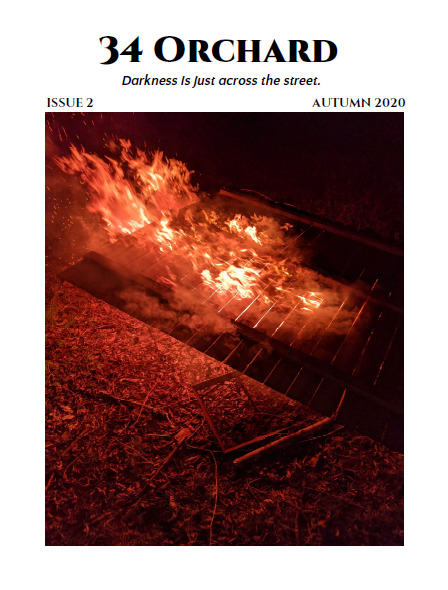
It’s been an interesting journey this time around, but I’m thrilled to announce the Table of Contents for 34 Orchard’s sophomore issue—coming to the magazine’s website here on November 10!
In this issue, twenty-one artists from everywhere burn worlds to the ground in terrifyingly beautiful ways, featuring the following art, fiction and poetry:
In the Witch House — Chris Campeau
fairy…
View On WordPress
#34 Orchard Fall 2020 issue#Amar Benchikha#Billy Bradshaw#Brandon Kawashima#C.M. Saunders#Carol Despeaux Fawcett#Chris Campeau#Clay McLeod Chapman#Corin Scher#dark fiction literary magazines#Desirae Terrien#Elizabeth J. Coleman#Ellen Andersen#Hunter Liguore#Jay Abramowitz#Juleigh Howard-Hobson#Kaitlyn Downing#Kali Meister#Liam Hogan#Lorna Wood#MK Roney#Page Sullivan#pandemic horror stories#R.A. Busby
0 notes